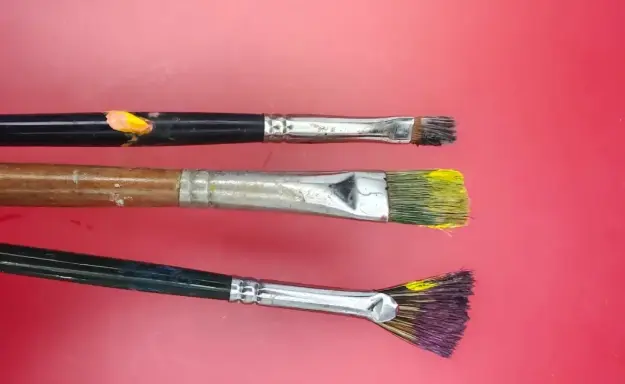Is oil painting toxic?Many people think that oil paintings are “bad for you”, why? Because oil paintings are made from mineral pigments and solvents, the chemical names of which are not familiar to us. In fact, as long as we know which ingredients are really dangerous, ventilate the studio well, use purifiers and low-toxicity alternative mediums, we can paint every picture with confidence.

What are the toxic elements in oil paints?
What are the toxic elements contained in oil paints?
Traditional oil paint formulas have some amount of soluble heavy metal compounds in them. To be precise, there are some soluble heavy metal elements involved in making the pigment develop color.
Soluble heavy metal elements like lead are common in lead white; lead and barium, two heavy metal elements, are found in chrome yellow and barium white in the past; there is also a combination of lead, barium and chromium, which can produce that opaque yellow-green color in the early days; in the more complicated traditional formulas, there are even lead, barium, chromium, antimony, cadmium or barium, chromium, antimony, cadmium and mercury, which are still found in military markings and industrial coatings These; and highly toxic complexes of chromium, antimony, cadmium, mercury, and arsenic, which are rare but have to be watched out for.
Also, ultramarine and Prussian blue, while less toxic, may be spiked with cobalt desiccants. For a few people, cobalt can also sensitize the skin.

What are the effects of heavy metals on the human body?
If we accidentally ingest these heavy elements, lead interferes with neurotransmitters, cadmium accumulates in the kidneys, hexavalent chromium is a known carcinogen, mercury affects the central nervous system, and arsenic can keratinize the skin. Although oil paints are in paste form and produce less dust than pastels, there is still a risk if you accidentally ingest them or grind dried paint film.
How can I tell the difference between toxic and non-toxic oil paints?
- Check the ASTM D-4236 label.
- Look for the “AP” mark and avoid colors marked “CL” or with skulls.
- Use organic synthetic pigments instead of heavy metals, such as benzimidazolone yellow instead of chrome yellow.
Selection criteria for non-toxic diluent solvents
What makes a good diluent?
“Non-toxic” does not mean that there is no risk at all, but rather that it has a very low content of volatile organic compounds (VOCs), virtually no aromatic hydrocarbons, a high flash point, and has been evaluated toxicologically and determined to have no appreciable risk to the health of adults. Odorless mineral oil (OMS) falls into this category.
What are some common good diluents?
- Gamsol: contains less than 0.01% aromatic hydrocarbons, has a flash point of 65°C, and has almost no odor.
- Sansodor: It is turpentine from Windsor Newton, less irritating than traditional turpentine, you can choose this better turpentine.
- Limonene-based solvent: it’s from citrus peels and has a fresh smell, but be aware that it may make people sensitive to light.
- Water-soluble oil thinner: It is specially formulated for mixing oil with water, and can be re-diluted and brushed with water, and dissolves exceptionally well.
How to use thinner for safety?
- For early thinning, the ratio of mineral oil to pigment is 1:1.
- Use less than 10 ml at a time and close the lid when finished.
- After the cured residue has settled, it is disposed of as hazardous waste to prevent spontaneous combustion at high temperatures.
Measures to stay safe in the studio
How can I keep my studio well ventilated?
You can open the windows on the diagonal of the studio and put a small fan to keep the air moving. If it is not convenient to open the windows in winter, install an exhaust fan and connect an activated carbon duct.
What is the need for an air purifier?
An air purifier with a VOC sensor and an activated carbon cartridge of 800 g or more can reduce the VOC concentration in the room by half in 30 minutes, which is particularly suitable for use in an apartment studio.
How should painters protect their skin?
Wear nitrile gloves and long-sleeved clothing when painting. Paint-stained cloths should be moistened with water and sealed to prevent spontaneous combustion. When sanding dry film or spraying varnish, wear a filter mask again.
Odors and Volatility of Oil Paint
What is the source of oil paint odors?
During the slow drying of oil paints in the studio, a small amount of aldehydes are produced by the oxidation of linseed oil, and the solvent evaporates to give an alkane smell.
What are the health effects of volatile components?
Short time exposure to high concentration of volatile ingredients will make you dizzy and throat uncomfortable; long time exposure to low dose may make you a little nervous.
How to deal with the odor of oil paints?
- Use OMS that has a low odor.
- After painting, ventilate for 10 minutes with strong exhaust.
- Put an activated charcoal packet in the area where you mix the colors to absorb the smell.
Risks of ingesting oil paints
How can I avoid accidentally ingesting oil paints?
Keep eating areas separate from painting areas, don’t keep brushes in your mouth, and keep children and pets away from paints.
What are the symptoms of accidental ingestion of heavy metals?
Acute symptoms are vomiting, a metallic taste in the mouth, and stomach pain; chronic symptoms are fingernails turning blue and black, joint pain, and easy fatigue.
What should I do if I accidentally ingest it?
You should take the label of the pigment tube to the doctor, and never induce vomiting by yourself; the doctor will perform chelation treatment.
Is oil painting toxic? Common Myths and Safe Painting Knowledge
What are common misconceptions about oil paints?
- “Oil paint must be more toxic than acrylic” – in fact, fluorescent acrylics may also contain formaldehyde releasers.
- “Odorless OMS is absolutely safe” – still need to pay attention to ventilation and fire prevention.
- “You can swallow it if it has the AP logo” – this does not mean you can eat it.
How to use and store oil paints properly?
Squeeze a little paint at a time, replenish when there is not enough, and keep the mouth of the tube clean. Keep the room temperature at 15 – 25℃ and humidity at 50% to slow down the yellowing process.
What safety details should I pay attention to during the painting process?
- The palette knife should be scraped clean every time you change colors.
- Wear a mask when handling flax-cured paint chips.
- Make it a good habit to clean your brushes, painting materials and brushes after painting.




